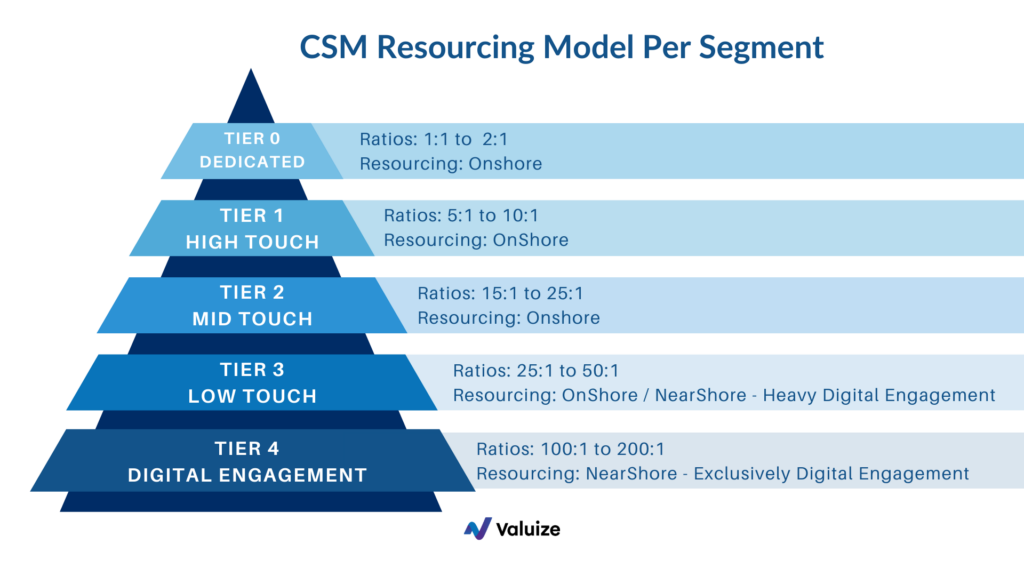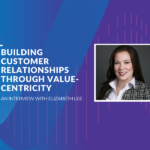Not All Customers Are Created Equal
Companies that exceed lead and revenue goals are 2.2X more likely to have and document personas and segments than companies that miss these targets (Cintell, 2016). Acknowledging this, many board rooms (and virtual town halls) have been buzzing around the recurring conversation of customer segmentation for years. What’s the right segmentation model for our organization? How should we prioritize our resources to best serve our customers? How should we strategically staff to support our different segments?
It’s time to put pen to paper. In this article, we provide a strategic and scalable approach to segmenting your customer base that will drive the greatest impact for your customers and your business.
Divide And Conquer
To scale and grow efficiently and effectively, enterprise organizations need to divide their customers into distinctive groups, based on a number of key considerations.
Take a moment to consider your customers and their most important attributes:
- Size and scale of their organization
- Annual revenue
- Type of business and segment they support
- Number of employees
- Geographic locations
- ARR spend with your company
- Alignment to your ideal customer profile
- Complexity of the solutions they have purchased from you
- Strategic significance of their brand is to your business
All of these factors will determine where your customers fall into your segmentation model and how you service them. Because every customer is different and has a different impact on your business, the investments you make to support your customers should not be homogeneous but tailored to each group. While investment in all customers is crucial, that investment should be commensurate with the strategic nature and investment that customer is making in you.
The Criticality Of Customer Segmentation
The one challenge that all Customer Success organizations face is resourcing. A proper customer segmentation model allows for the effective allocation of resources and investments to be made to maximize customer adoption and expansion.
Placing the right resources on the right accounts sets you and your customers up for the greatest success. With a segmentation strategy, you can decide the level of resourcing and ratios to apply to a customer segment; if those resources are on-shore, near shore, or if a digital engagement model is the best approach. Segmentation truly allows you to manage your Cost to Serve and ensure you have the right Customer Retention Costs (CRC) to support your business.
What’s the difference between a “Sales Segmentation” and a “Customer Success Segmentation”? Sales segmentation is typically based on geographic territories and company size whereas Customer Success Segmentation, the focus of this article, is based on the importance and criticality to your company’s performance-based current and future revenue.
Are You Neglecting Your Lower Tier Segments?
As a business leader with limited resources and budget constraints, it can be tempting to put all of your CS investments in your top tier customers. That’s where all the revenue comes from – in our experience, 60% to 70% of your revenue most likely comes from the top 20% to 30% of your customer base. However, you shouldn’t lose sight of your lower tier customers for two extremely important reasons:
- Your Tier 3 & 4 customers will become your next Tier 1 & 2 customers, if you properly nurture and grow them.
- Tier 3 & 4 customers normally have Gross Retention Rate (GRR) between 70%-80% due to lack of attention and adoption of this install base. Because of this, you are potentially seeing a lot of revenue attrition in these lower tiers. If you aspire to achieve a 95% GRR, you need to improve your Tier 3 & 4 customers – those nickels and dimes add up over time.
By focusing on these lower tier segments, you’ll ensure sustainable and scalable growth for your business well into the future.
An Executive Approach To Customer Segmentation
When building out your segmentation model, we suggest you focus on 2 main metrics; Annual Recurring Revenue (ARR) and Annualized Untapped Revenue Potential (AURP). At Valuize, we call the combination of these two key indicators into one powerhouse measurement: Adjusted ARR.
Adj. ARR = ARR + AURP
- Annual Recurring Revenue (ARR): Value of the contracted recurring revenue components of your term subscriptions normalized to a one-year period
- Annualized Untapped Revenue Potential (AURP): Revenues (annualized) a company is capable of generating if it were to take full advantage of the opportunities available Including upsell, cross-sell and expansions. AURP could be based on future opportunities already identified or a propensity to expand revenue based on fit and market for your solution.
Building Your Segmentation Model
While every company will have its unique differences and needs, here’s a segmentation model that should be a good starting point as you consider and create your first segmentation blueprint for your organization:
- Tier 0: 0.5% of customer base, representing ~15% of Adj. ARR
- Tier 1: 10% of customer base, representing ~30% of Adj. ARR
- Tier 2: 15% of customer base, representing ~25% of Adj. ARR
- Tier 3: 30% of customer base, representing ~20% of Adj. ARR
- Tier 4: 45% of customer base, representing ~10% of Adj. ARR
Note: in addition to ARR and AURP, you should also consider how strategic your customers are to your brand. If there are certain customers that you must invest in who don’t have a high Adjusted ARR, you should consider manually moving them into higher tiers. Keep in mind, for every customer you move up you should also move one down, to help maintain the right resource investment.
Defining Tier 0
In most subscription companies, there is always a subset of customers that are either very large or very strategic. It is critical for your organization to secure these customers at any cost. These are typically your largest customers or critical brands that would be a devastating business loss. We recommend that you try to keep Tier 0 to a select handful of customers, and no more than 0.5% of your customer base. You are going to invest heavily in these customers so it is important to keep this an exclusive list as something that is agreed upon by both your CRO and CCO.
Understanding Your Segmentation Coverage & Investment
Once you’ve launched your Customer Success segmentation model, how should you approach CSM coverage and ratios? Below, we’ve proposed a hierarchy to help you maximize your Customer Success investments in the right places.

Other Segmentation Considerations
- Geographic Coverage: When building your segmentation model, you should consider geo-specific models and break out your adjusted ARR calculation at the geographic level,. i.e. Americas, EMEA, APJ. Most geographies are at a different level of maturity and growth stage. For example, in the Americas, a $1 Million ARR Customer might be as critical as a $500k ARR Customer in APAC. Therefore, both would be in Tier 1.
- Product Specialization: While segmentation models typically do not take product specialization into account, that is something you must consider when building your models. Do you have very different products or domains that you sell to? If so, you might look at a segmentation model that includes product specialization and/or overlays, or creating a special CSM coverage model for specific products.
- Staffing & Resource Availability: Segmentation models work best when you have adequate resources to support the coverage models. For example, APJ might be a growth area for your organization, so you might only have appointed a handful of CSMs to cover that region. However, it’s difficult to build a proper segmentation and coverage model with only a handful of CSMs. In this case, you might consider only applying the segmentation to the other regions first, and hold off on APJ until that team grows.
- Digital Capabilities: Digital engagement is critical to scaling your tier 4 low- touch model, but can also be leveraged to drive scale and productivity in your higher tiers as well. Design and develop a digital engagement strategy that supports your segmentation model.
Scale And Grow Your Business Through Customer Segmentation
To exceed a 95% renewal rate, you need to implement a segmentation model that also incorporates and engages your Tier 3 & 4 customers. While most companies funnel all of their energy and resources into Tier 1 & 2 accounts, your Tier 3 & 4 customers are essential to sustaining and scaling your recurring revenue growth.
Is your segmentation model driving optimal results? Test the effectiveness of your current approach by running it through the operational improvement cycle from our latest article to uncover opportunities and maximize efficiency.





